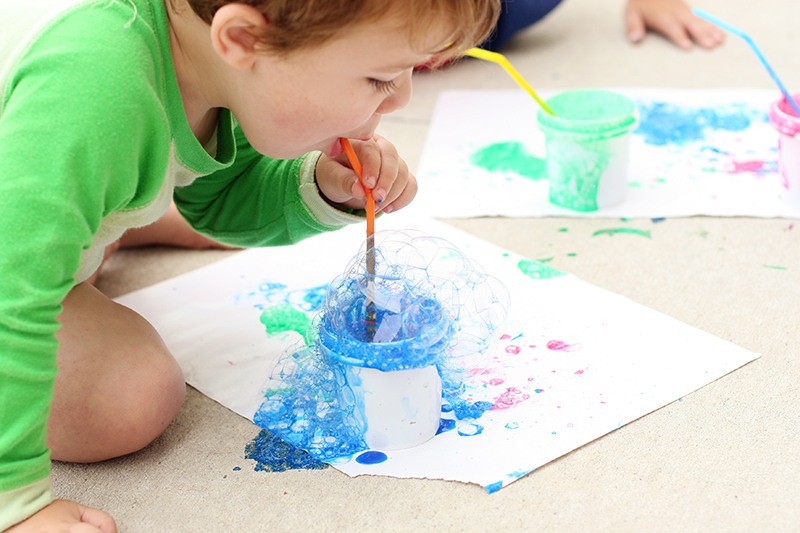Art activities for preschoolers are more than just a bit of fun—they’re little building blocks for growing minds. Did you know that when kids paint, draw, or play with colors, it helps their brains get stronger and more flexible? These creative activities help kids learn how to think through problems and manage their feelings, all while having a blast.
Math & ELA | PreK To Grade 5
Kids see fun.
You see real learning outcomes.
Watch your kids fall in love with math & reading through our scientifically designed curriculum.
Parents, try for free Teachers, use for free
So next time your child picks up a crayon, remember—they’re not just making a mess; they’re learning and growing in ways that will last a lifetime. Here are some easy and fun art activities to try with your preschooler.
1. Marble Rolling Art
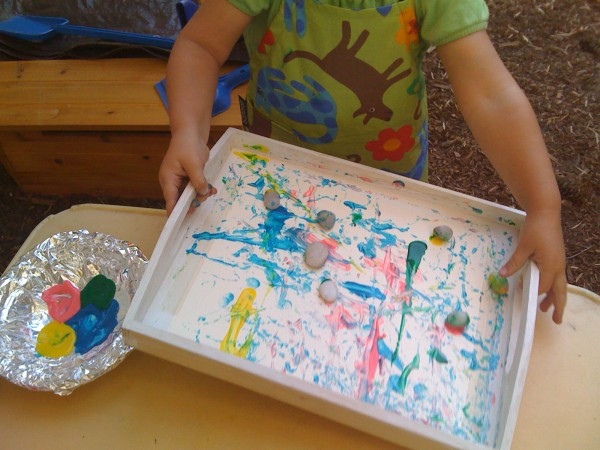
Marble rolling art is a dynamic and hands-on activity that’s full of surprises. Preschoolers will enjoy watching the marbles create unpredictable patterns as they roll around, helping them understand motion and cause-and-effect while also boosting their hand-eye coordination. This is one of the most exciting visual arts activities for young children.
Materials Required:
- Shallow box or tray
- Paper
- Marbles
- Non-toxic paint
How to Do It:
- Place a sheet of paper inside the shallow box or tray.
- Add a few drops of different colored paint on the paper.
Drop in a few marbles and let your child tilt the box to roll the marbles around, creating colorful, abstract patterns.
2. Alphabet Coloring Fun
Begin here
These alphabet coloring worksheets offer a fun and interactive way for your child to learn their letters while engaging in art. Each worksheet is centered around a specific letter, and your child is tasked with identifying and coloring images that start with that letter. For example, they’ll color an ant, an apple, and an airplane for the letter A, or a balloon and a banana for the letter B.
This activity combines letter recognition with creative coloring, helping your child associate letters with objects while they explore their artistic side. This is one of the most creative art ideas to introduce preschoolers to letters while having fun.
Related Reading: Best Color Activities for Preschoolers to Boost Creativity
3. Online Coloring Games
Are you tired of cleaning up after messy coloring sessions with your preschooler? Why not try a mess-free alternative that’s just as fun? Here are some fun online coloring games that offer your child a world of creativity, learning, and excitement—all without the cleanup!
With these games, your child gets a chance to develop their creativity while picking up fascinating facts. Each introduces your child to a lively, interactive character who guides them through the coloring process and shares cool facts about the items they’re coloring. Whether it’s a roaring lion, a shiny trumpet, or a distant planet, your child will discover something new with every brushstroke.
Your child can create beautiful, detailed artwork with various tools like paint brushes, stickers, and even spray cans. These games are easy art activities for preschoolers that allows them to explore different themes like animals, space, and food in a fun way.
Begin here
4. Count & Color
Begin here
Why not add an educational twist to your child’s coloring time? These “Count & Color” worksheets offer a fun way for kids to enjoy coloring while also practicing their counting skills. Each worksheet asks the child to identify the quantity of objects, and then color in the exact number shown. For example, if the number is 2, they’ll color two oranges; if it’s 5, they’ll color five strawberries.
Your little one will enjoy identifying the correct quantity, coloring within the lines, and developing fine motor skills all at once. These activities serve as great preschool art projects while also enhancing numeracy skills.
5. Ice Painting
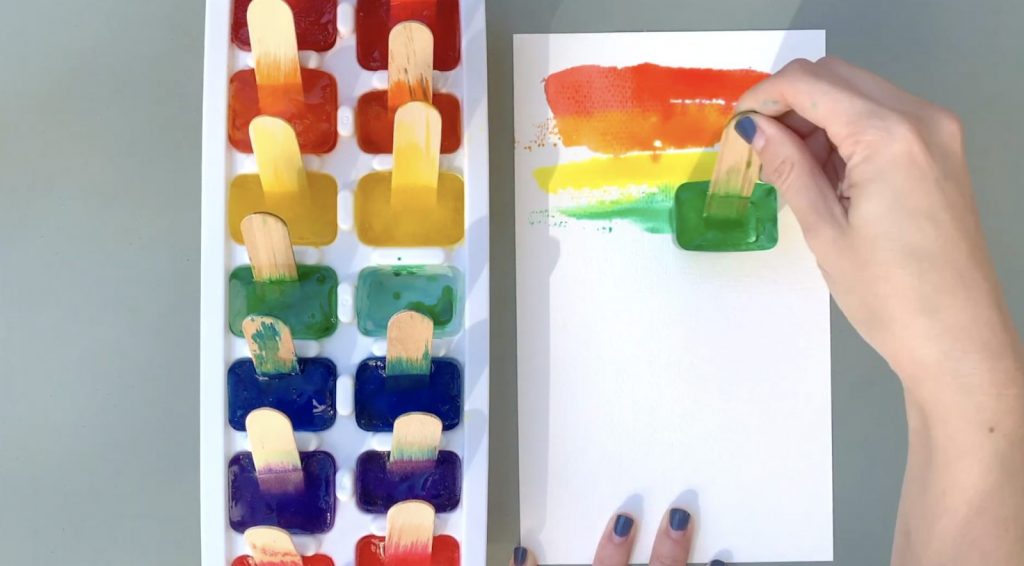
Ice painting is a fun and sensory-rich activity that preschoolers will love. It is one of the most fun popsicle stick crafts for preschoolers. As they paint with melting ice, kids explore color blending and the changing states of water, all while creating beautiful, unpredictable patterns. This activity encourages creativity and helps develop fine motor skills. It’s a perfect choice for simple art projects for preschoolers that combine fun and learning.
Materials Required:
- Colored water (using food coloring)
- Ice tray
- Popsicle sticks
- Paper
How to Do It:
- Fill an ice tray with colored water and insert popsicle sticks into each section.
- Freeze the tray until the water is solid.
- Once frozen, give the ice cubes to your child and let them paint on paper as the ice melts, creating unique and colorful designs.
6. Glow Stick Drawing
Glow stick drawing is an exciting way for preschoolers to explore art in the dark. The glowing lights enhance their imagination, allowing them to express creativity in a new and magical way, while also playing with concepts of light and movement. This activity is ideal for kids interested in fine arts activities, encouraging creative play.
Materials Required:
- Glow sticks
- Dark room or evening time
How to Do It:
- Activate the glow sticks by bending them until they light up.
- Turn off the lights or wait until it’s dark outside.
- Let your child use the glow sticks to “draw” in the air.
Related Reading: Best Drawing Ideas for Kids They Will Love
7. Shadow Tracing
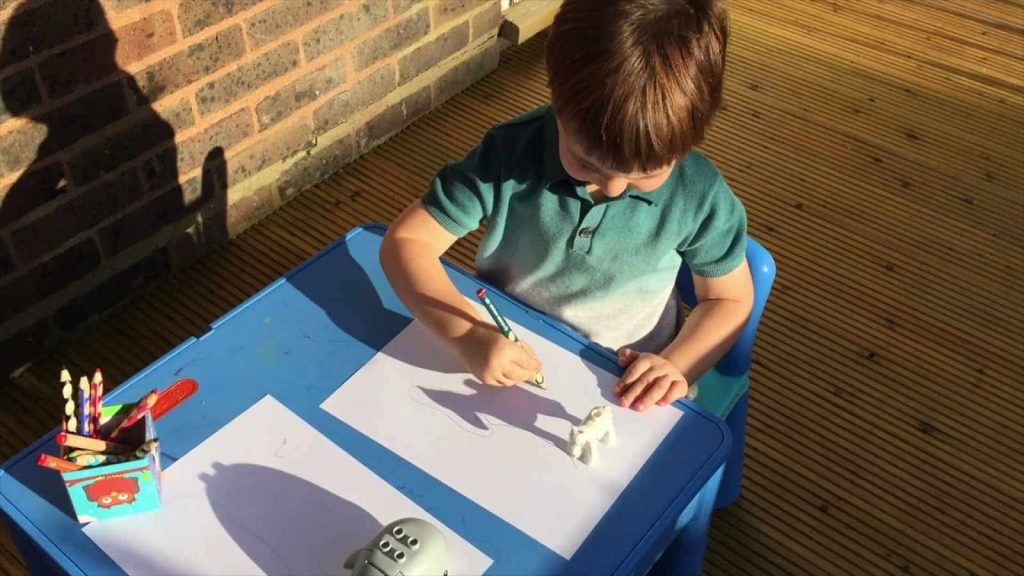
Shadow tracing is a fun way for preschoolers to learn about light and shapes. By tracing shadows cast by objects, kids can create unique outlines and then bring them to life with color, boosting their observation skills and creativity. It’s one of the best preschool art activities for combining creativity with scientific exploration.
Materials Required:
- Light source (lamp or sunlight)
- Various objects (toys, plants, etc.)
- Paper
- Pencils or markers
How to Do It:
- Place the objects in front of a light source to cast a shadow on a piece of paper.
- Have your child trace the outline of the shadow with a pencil.
- Let them color in the traced shapes to create their own shadow-inspired artwork.
8. Salt and Paint Art
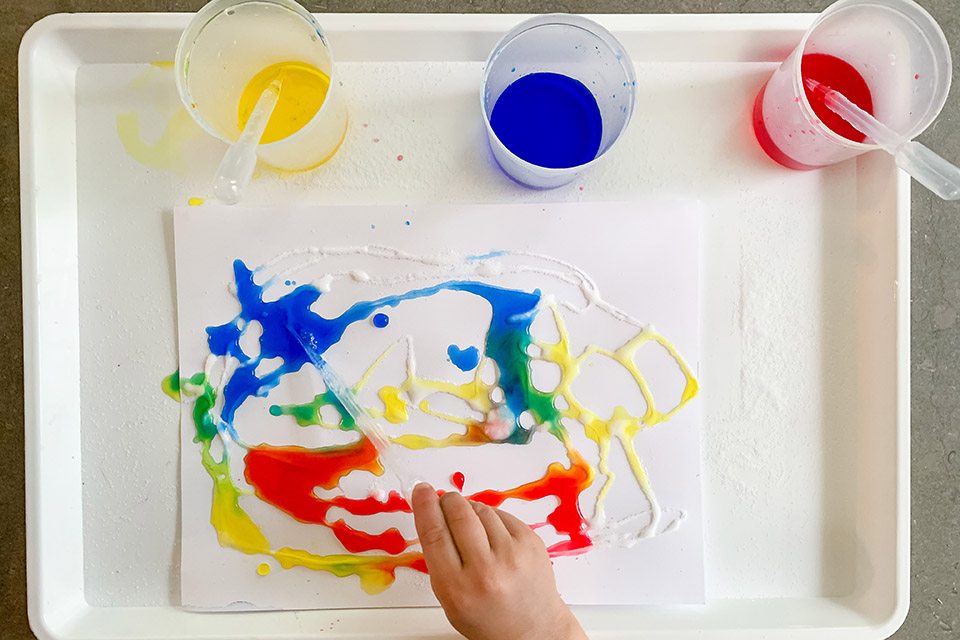
Salt and paint art is a simple yet fascinating activity where preschoolers can watch colors spread and blend in unexpected ways. This activity combines texture and color, helping kids explore absorption and color mixing.
Materials Required:
- White glue
- Salt
- Watercolor paint or food coloring
- Paper
How to Do It:
- Have your child draw a design on paper using white glue.
- Sprinkle salt generously over the glue and shake off the excess.
- Use a dropper or brush to gently drop watercolor paint or diluted food coloring onto the salt, watching as the colors spread and mix along the lines.
9. Bubble Wrap Stomping
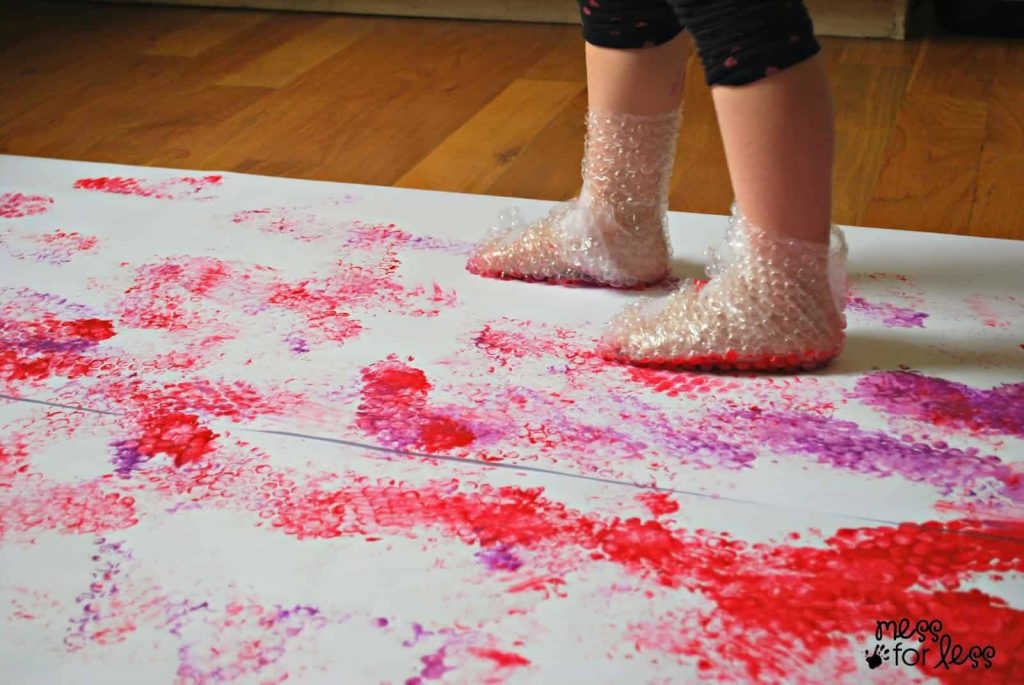
Bubble wrap stomping is a joyful and sensory-filled activity that preschoolers will love. Stomping on painted bubble wrap not only creates fun and unique prints but also helps release energy and enhances gross motor skills. This is a perfect example of pre-k art projects that get kids moving while being creative.
Materials Required:
- Bubble wrap
- Non-toxic paint
- Large sheet of paper or fabric
How to Do It:
- Spread paint onto a sheet of bubble wrap.
- Lay a large piece of paper or fabric on the floor.
- Let your child stomp on the painted bubble wrap with bare feet, transferring the paint onto the paper to create colorful and textured prints.
10. Magic Milk Swirls
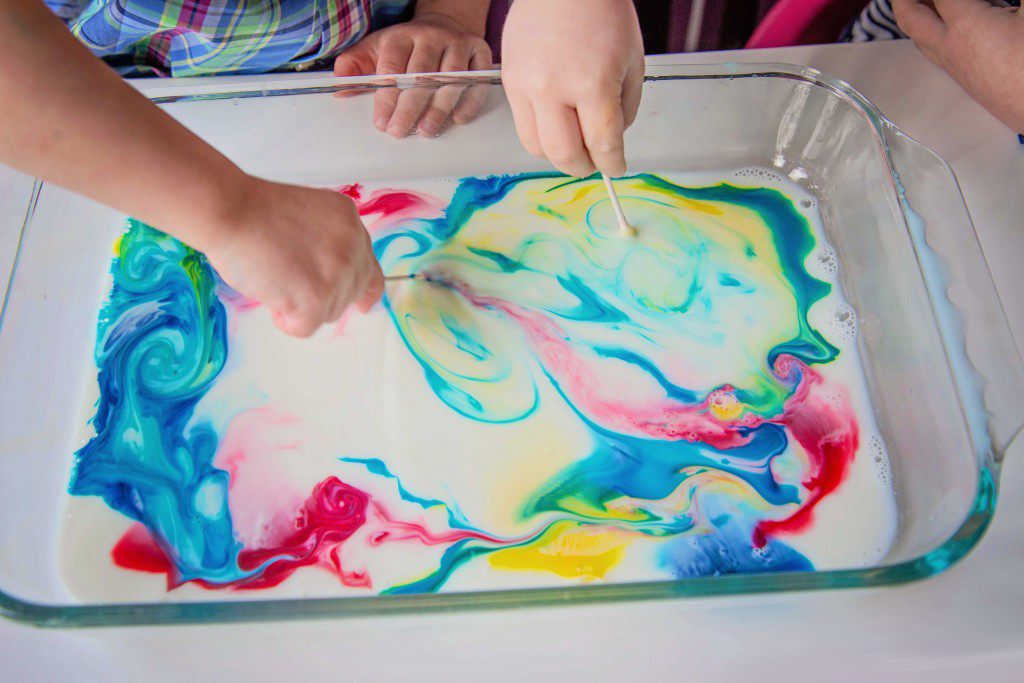
Magic milk swirls turn simple ingredients into a mesmerizing art experiment. As preschoolers watch colors dance and mix in milk, they learn about chemical reactions while enjoying the beauty of swirling colors.
Materials Required:
- Milk
- Food coloring
- Dish soap
- Cotton swabs
- Shallow dish
How to Do It:
- Pour milk into a shallow dish until it just covers the bottom.
- Add a few drops of different food coloring to the milk.
- Dip a cotton swab in dish soap and touch it to the surface of the milk. Watch as the colors swirl and mix, creating beautiful patterns.
11. Mirror Drawing
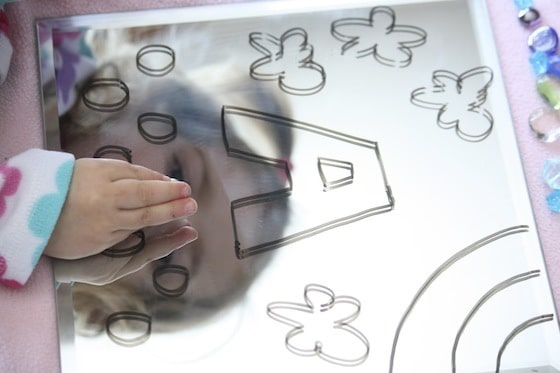
Mirror drawing is a fun and interactive way for preschoolers to explore symmetry and self-awareness. By drawing on a mirror, kids can see their reflections and add creative details, boosting their imagination and spatial awareness.
Materials Required:
- Mirror
- Clear plastic sheet or dry-erase markers
- Tape (if using a plastic sheet)
How to Do It:
- If using a clear plastic sheet, tape it securely to the mirror.
- Give your child dry-erase markers or crayons and let them draw on the mirror or plastic sheet.
- Encourage them to interact with their reflection, adding fun designs to their faces or the surrounding space.
12. Mud Painting
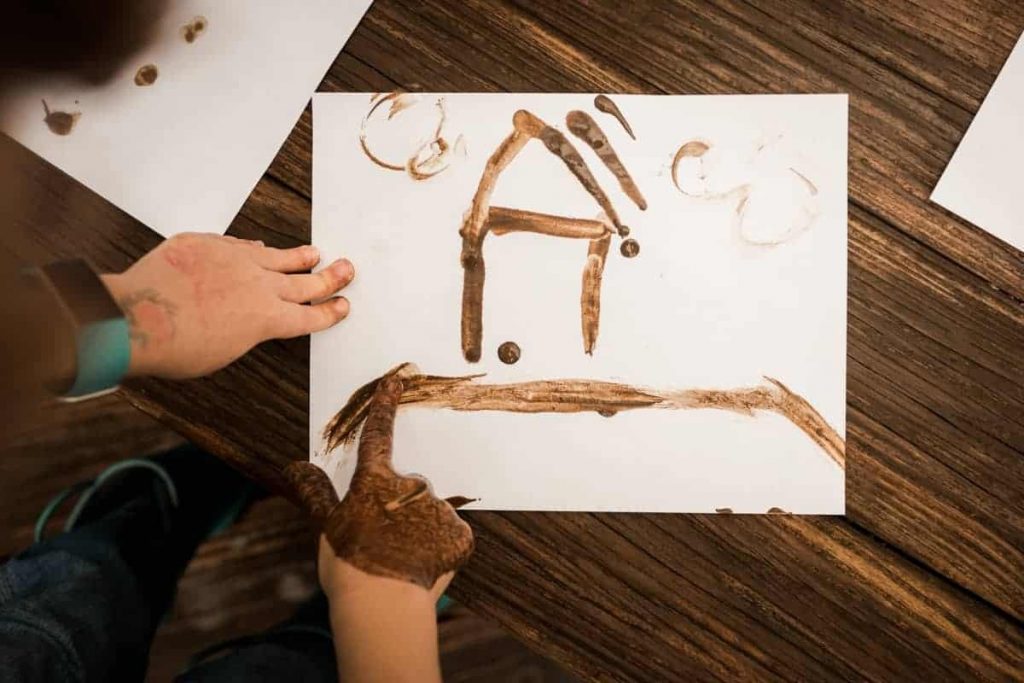
Mud painting is a wonderful way for preschoolers to connect with nature while creating earthy art. Using mud as paint, kids explore different textures and natural materials, which enhances sensory development and creativity.
Materials Required:
- Dirt
- Water
- Rocks, leaves, or sticks
- Paper or large rocks as a canvas
How to Do It:
- Mix dirt with water to create a thick mud.
- Let your child use the mud as paint, either on paper or directly on large rocks.
- Encourage them to add leaves, sticks, or other natural materials to their artwork for added texture and interest.
Related Reading: Easy Painting Ideas for Kids
13. Fizzy Art
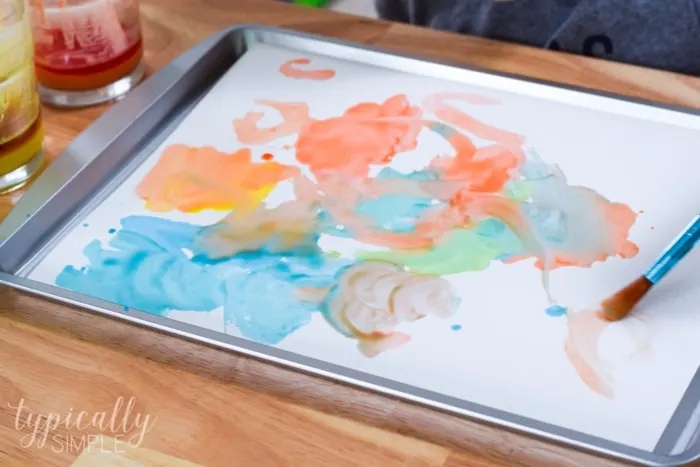
Fizzy art is a fun and scientific art project that combines creativity with a simple chemical reaction. Preschoolers will love watching their artwork fizz and bubble as they experiment with baking soda and vinegar, making it a fun way to explore cause and effect.
Materials Required:
- Baking soda
- Water
- Vinegar
- Food coloring
- Dropper or spoon
- Paper or a shallow tray
How to Do It:
- Mix baking soda with a small amount of water to create a paste, then spread it thinly on paper or in a shallow tray.
- Prepare colored vinegar by adding a few drops of food coloring to vinegar.
- Use a dropper or spoon to drip the colored vinegar onto the baking soda paste, watching as it fizzes and creates colorful, bubbly patterns.
14. Collage Creation
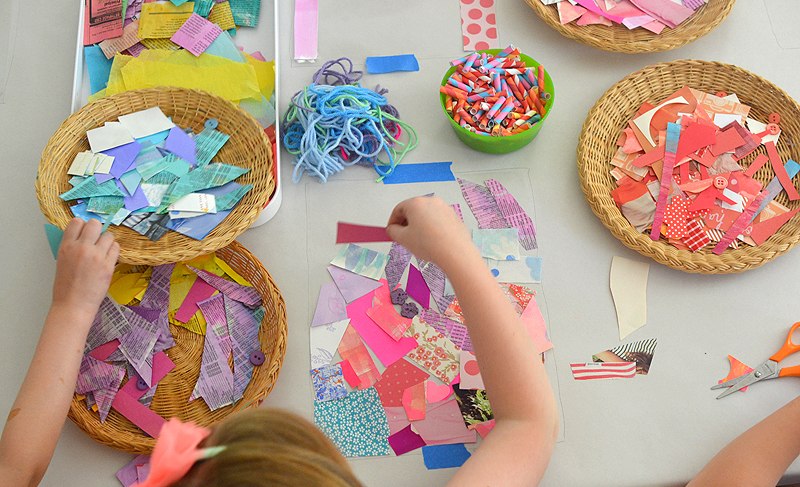
Collage creation is a fantastic way for preschoolers to explore different textures and materials while creating a unique piece of art. This activity allows children to layer and combine materials to create a colorful and creative design.
Materials Required:
- Colored paper
- Magazines
- Fabric scraps
- Glue
- Scissors
- Cardboard or large sheet of paper
How to Do It:
- Provide your child with a variety of materials like paper, magazines, or fabric scraps.
- Let them cut out shapes or images that catch their attention.
- Have them glue these materials onto a piece of cardboard or paper to create a collage.
- Encourage them to layer and combine different textures and colors to make their own creative masterpiece.
15. Finger Painting
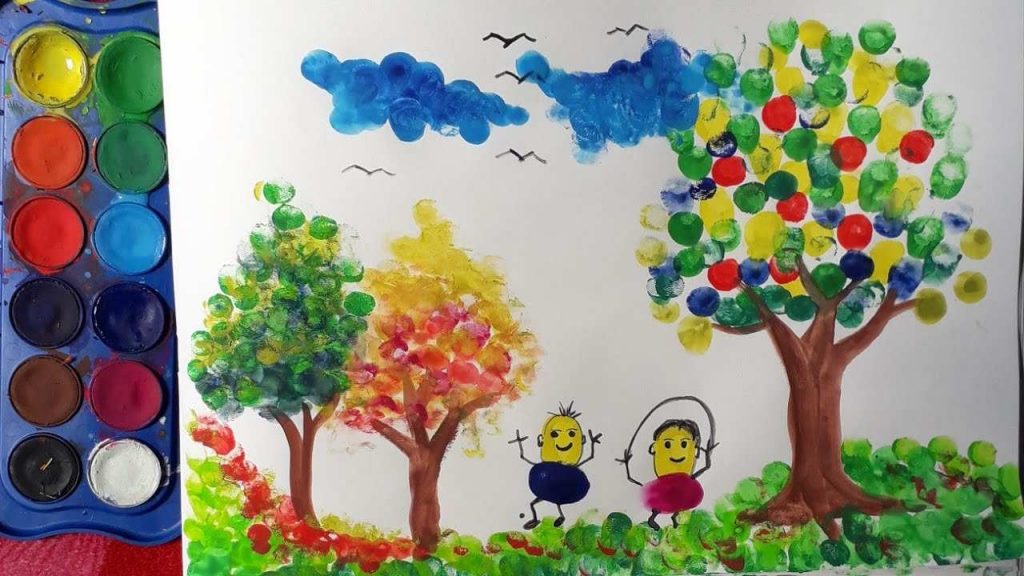
This is one of the classic finger painting ideas that allows preschoolers to engage in sensory play while exploring colors and textures with their hands.
Materials Required:
- Non-toxic finger paints
- Large sheet of paper or canvas
- Cotton swabs (optional)
- Sponges (optional)
How to Do It:
- Set up a large sheet of paper or canvas on a table or the floor.
- Pour different colors of finger paint onto a palette or plate.
- Encourage your child to use their fingers to paint shapes, patterns, or even abstract designs.
- For more fun, introduce tools like cotton swabs or sponges to create new textures and patterns.
16. Rainbow Art
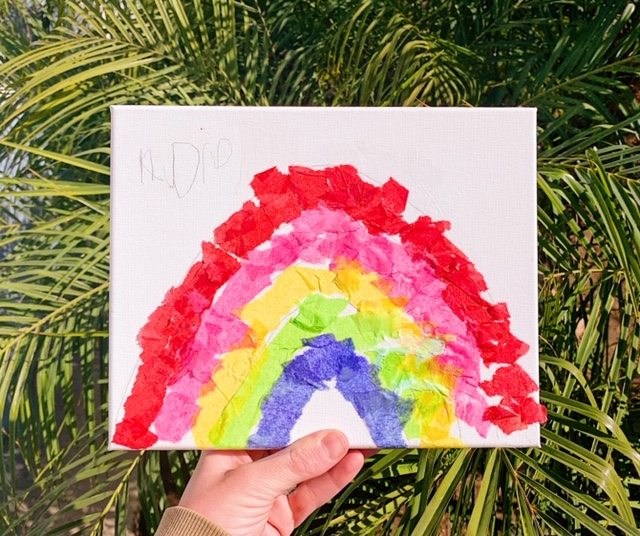
Rainbow art is a vibrant and engaging way for preschoolers to explore color mixing while creating beautiful rainbow-themed artwork.
Materials Required:
- Paint in primary colors (red, yellow, blue)
- Brushes or sponges
- Large paper or canvas
- Markers or crayons (optional)
How to Do It:
- Begin by explaining the colors of the rainbow to your child.
- Let them use paint brushes or sponges to create arcs of different colors across a large piece of paper.
- Encourage them to experiment with mixing primary colors to create secondary colors for a full rainbow effect.
- Optionally, they can use markers or crayons to add details like clouds or sunshine to their rainbow art.
Related Reading: Best Rainbow Crafts and Activities Kids
Conclusion
Engaging in art activities for preschoolers fosters creativity and supports their cognitive, motor, and emotional development. From colorful crafts to hands-on sensory experiences, these activities offer endless opportunities for learning and growth. Encourage your child to explore, create, and express themselves through these fun and educational projects.
Related Reading: Super Cool Art Activities for Kids
Frequently Asked Questions (FAQs)
What are the art skills of a 4 year old?
At 4 years old, children typically begin to develop fine motor skills, such as holding crayons or brushes, and they start experimenting with shapes, colors, and patterns. They also begin to express creativity through simple drawings, painting, and crafting.
How do you teach art creatively?
To teach art creatively, encourage exploration by providing diverse materials and tools. Allow children to express themselves freely, introduce fun themes, and blend art with storytelling, nature, or music to spark their imagination.
What are some good art activities for 3-4 year olds?
Some good art activities for 3-4 year olds include finger painting, collage creation, rainbow art, and simple crafts like making paper animals. These activities are fun, easy to do, and help develop fine motor skills while fostering creativity.

















